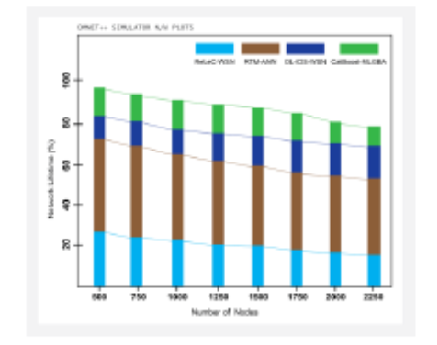


Indian Journal of Science and Technology
DOI: 10.17485/IJST/v16i47.2496
Year: 2023, Volume: 16, Issue: 47, Pages: 4547-4560
Original Article
R Kowsalya1*, C V Banupriya2
1Assistant Professor and Head, Department of Computer Science (PG), PSGR Krishnammal College for Women, Coimbatore, Tamil Nadu, India
2Assistant Professor, Department of Computer Science, PSG College of Arts & Science, Coimbatore, Tamil Nadu, India
*Corresponding Author
Email: [email protected]
Received Date:02 October 2023, Accepted Date:16 October 2023, Published Date:30 December 2023
Objectives: To propose a novel AI-based quantum key distribution optimization model to detect abnormal sensor readings, communication pattern between nodes, and intrusions during data transformation in long-range wireless sensor networks (LoRA-WSNs). In order to optimize the QKD in WSNs, machine learning boosting techniques are employed to minimize data loss and maximize data integrity. Methods: The CatBoost machine learning-based gradient boosting algorithm (CatBoost-MLGBA) is employed for QKD optimization and to detect abnormal node communications and patterns during data transfer by training historical network data. The linear regression method (LRM) with key generation rates is used to predict network attacks, which helps optimize the QKD more effectively. Lasso Regularization (L1R) is utilized to spot and recover the data in networks, and Deep Q-Networks (DQN-WSN) combined with the shortest path method is used to find alternate routing for the finest node search and data transfer. The WSN-DS historical dataset is utilized to train the CatBoost-MLGBA model to detect anomalies effectively. The OMNET++ tool is used to assess the performance of the proposed CatBoost-MLGBA model by comparing it with prevailing protocols such as ReLeC-WSN, RTM-ANN, and DL-IDSWSN. Findings: The new AI based optimization model, CatBoost-MLGBA outperforms the existing protocols in preventing data loss by enhancing security features. The proven results show that the data loss is minimized to 10%, with a 9% energy consumption rate, 95% network lifetime, 97% PDR rate, 91% robustness to anomaly attacks, and 6 seconds data transmission speed rate. Novelty: The CatBoost-MLGBA model has the ability to enhance security features and prevent data loss during data transfer in LoRa-WSNs. The new method effectively optimizes the key distribution for secured data transmission and improves the packet delivery ratio. The challenges of the prevailing security protocols, such as ReLeC-WSN, RTM-ANN, and DL-IDSWSN, are addressed.
Keywords: WSN Security, CatBoost Model, Advanced Networking, Energy Efficiency, Key Optimization Model, Gradient Boost Method
© 2023 Kowsalya & Banupriya. This is an open-access article distributed under the terms of the Creative Commons Attribution License, which permits unrestricted use, distribution, and reproduction in any medium, provided the original author and source are credited. Published By Indian Society for Education and Environment (iSee)
Subscribe now for latest articles and news.